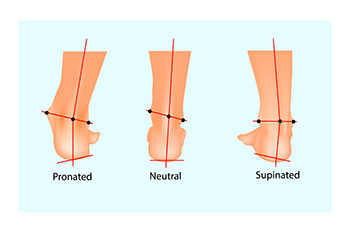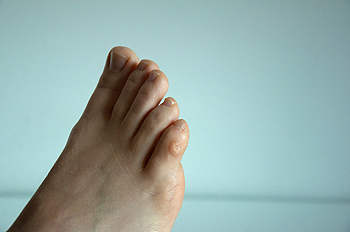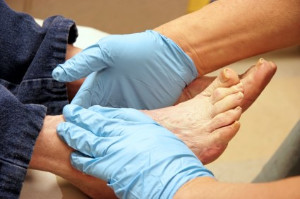Connect With Us
Blog
Items filtered by date: February 2024
Signs and Causes of Overpronation

When the foot and ankle excessively roll inward and downward, often observed in individuals with flat feet, it is a sign of overpronation. This abnormal gait pattern can strain muscles, ligaments, and joints, which may lead to heel pain, shin splints, and lower back pain. While some may not experience symptoms, others may suffer from persistent discomfort in their lower extremities, including midfoot or hip pain. Distinguishing between overpronation and underpronation, also called supination, is important. While overpronation involves excessive inward rolling of the ankle, underpronation is characterized by insufficient foot movement, often associated with a high arch foot type. If you experience foot pain that may involve overpronation, seeking guidance from a chiropodist is suggested. A chiropodist can provide personalized assessment and treatment options tailored to your specific needs.
The biomechanics of your feet play an important role in your foot health. To learn more, please consult with one of our chiropodists from West Toronto Foot & Ankle Clinic Inc. . Our chiropodist can help you maintain the health of your lower limbs and your mobility.
Foot biomechanics refers to the study of the structure, function, and motion of the feet. The feet and ankles are a complex system consisting of many bones, joints, ligaments, muscles, and tendons that work together to move your feet. Understanding the unique biomechanics of your own feet can help you and your chiropodist make informed decisions about your foot health care. This includes decisions about the best preventive measures to avoid foot pain, the best treatment options for various foot problems, and finding the best shoes for your feet.
If you have any questions, please feel free to contact our office located in . We offer the newest diagnostic and treatment technologies for all your foot care needs.
Conditions Potentially Linked to Adult Flat Feet

Adult flat feet, a condition where the arches of the feet have collapsed or never fully developed, can potentially lead to various associated issues. One primary concern is overpronation, where the foot rolls inward excessively during walking, impacting the alignment of the lower limbs and potentially causing discomfort. This altered biomechanics can contribute to shin splints, as the muscles and tendons undergo increased stress. The misalignment may also trigger plantar fasciitis, resulting in inflammation and heel pain. Bunions, a deformity of the big toe joint, are another potential consequence, as the flattened arch alters the distribution of weight on the foot. Furthermore, adult flat feet can contribute to Achilles tendonitis due to increased strain on the Achilles tendon. If you have flat feet, it is strongly urged that you are under the care of a chiropodist who can offer you appropriate foot stretches for relief, in addition to correct treatment techniques.
Flat feet are a common foot condition. If you are experiencing pain or discomfort due to flat feet, please consult with one of our chiropodists from West Toronto Foot & Ankle Clinic Inc. . Our chiropodist will assess your condition and provide you with quality foot and ankle treatment.
What Are Flat Feet?
Flat feet are feet that do not have a well-defined arch in the middle of the sole of the foot. Flat feet may be flexible or rigid. Flexible flat feet have an arch when there is no pressure put on the foot, such as when one is sitting, but the arch disappears upon standing. Rigid flat feet lack an arch regardless of whether one is standing or not.
Causes
Flat feet can be present from birth or acquired over time due to a weakening of the ligaments in the arch. Sometimes flat feet are caused by illnesses, injuries, or pregnancy.
Symptoms
Flat feet often cause no noticeable symptoms. However, some people may experience pain and discomfort due to their flat feet.
Symptoms associated with flat feet include:
- Pain in the arch, heel, ankle, or along the outside of the foot
- Overpronation of the foot
- Shin splints
- Aching or fatigue in the feet or legs
- Pain in the knees, hips, or lower back
Treatment
In cases where flat feet cause symptoms, there are various treatments available. Wearing orthotic inserts in your shoes to provide more arch support, performing stretches, and taking medications may improve your symptoms. If you are overweight, losing weight can help relieve pressure on the feet. In severe cases, surgery may be considered.
If you have any questions, please feel free to contact our office located in . We offer the newest diagnostic and treatment technologies for all your foot care needs.
Managing Corns on the Feet

Corns and calluses may seem like small inconveniences, but they can cause significant discomfort if left untreated. Corns are cone-shaped bumps that typically appear on the smaller toes, especially over joints. They can be tender and painful, making every step a challenge. Calluses, on the other hand, are broader and flatter, typically found on the soles of the feet. There are various reasons why corns can develop. In most cases, it is friction and pressure, particularly from wearing tight or ill-fitting shoes. Those individuals with toe deformities such as hammertoe are especially susceptible to corns. Diagnosis is based on appearance and location, and treatment often involves removing the corn or callus and applying skin-softening agents. Prevention of corns and calluses is key. It pays to invest in properly fitting footwear and consider orthotic inserts if necessary. If you have corns or calluses that interfere with your daily activities, it is suggested that you schedule an appointment with a chiropodist for proper care and treatment.
Corns are small bumps or dry, hardened skin that can arise on the feet, usually in response to friction. Corns can be asymptomatic, or they can be uncomfortable or painful. If you have corns that are bothering you, please consult with one of our chiropodists from West Toronto Foot & Ankle Clinic Inc. . Our chiropodist can help you maintain the health of your lower limbs and your mobility.
There are three types of corns:
- Hard corns
- Often occur on the tops of toes
- Feature a hard core surrounded by dry, irritated skin
- Can be painful
- Soft corns
- Often occur in between the toes
- Soft due to constant exposure to sweat
- Can be painful
- Seed corns
- Tiny
- Often occur on the soles of the feet
- Usually asymptomatic
Corns can be prevented by wearing shoes that fit properly. They are typically benign and don’t require medical treatment. However, if your corns are causing you pain or discomfort, don’t hesitate to reach out to a chiropodist near you for treatment options. If you have any questions, please feel free to contact our office located in . We offer the newest diagnostic and treatment technologies for all your foot care needs.
Are You Suffering From Nerve Damage?
How Diabetes Affects the Feet

Diabetes poses significant risks to foot health due to its impact on blood glucose levels, which can lead to peripheral neuropathy and peripheral vascular disease. Peripheral neuropathy results in nerve damage that reduces sensation in the feet, while peripheral vascular disease affects blood circulation that can hinder the healing process. This combination of diabetes side effects increases the likelihood of developing foot ulcers and other complications. Early detection of symptoms such as numbness, tingling, changes in foot color, or slow-healing wounds is essential. Managing diabetes effectively through stable blood sugar levels, quitting smoking, and staying physically active is beneficial. To further reduce the effects of diabetes on the feet, it is important to practice good foot hygiene and wear supportive shoes and socks. It is also suggested that you schedule regular visits with a chiropodist for tests for nerve function and circulation, in addition to monitoring the health of your feet.
Diabetes can cause serious problems in the lower limbs if proper preventive measures are not taken and diabetic wound care is not performed. If you would like to learn more about caring for diabetic feet, please consult with one of our chiropodists from West Toronto Foot & Ankle Clinic Inc. . Our chiropodist can help you maintain the health of your lower limbs and your mobility.
Diabetes can lead to a host of foot and ankle complications, including:
- Poor circulation
- Peripheral neuropathy
- Diabetic foot wounds and ulcers
- Infection
- Corns and calluses
- Dry, cracked skin
- Nail disorders
- Hammertoes
- Bunions
- Charcot foot
If you have diabetes, you must be vigilant of any changes in your foot health. This is best done through daily foot inspections. Using a mirror to help you if necessary, look for any:
- Cuts, scrapes, sores, or wounds
- Bruising or discoloration
- Swelling
- Rash
- Foul odor
- Nail changes
- Hair loss
- Warmth and inflammation
- Deformities
- Lower limb pain
- Strange sensations (numbness, tingling, burning, pins, and needles)
If you detect anything unusual, seek the care of a chiropodist as soon as possible. If you have any questions, please feel free to contact our office located in . We offer the newest diagnostic and treatment technologies for all your foot care needs.
Blog Archives
- November 2025
- October 2025
- September 2025
- August 2025
- July 2025
- June 2025
- May 2025
- April 2025
- March 2025
- February 2025
- January 2025
- December 2024
- November 2024
- October 2024
- September 2024
- August 2024
- July 2024
- June 2024
- May 2024
- April 2024
- March 2024
- February 2024
- January 2024
- December 2023
- November 2023
- October 2023
- September 2023
- August 2023
- July 2023
- June 2023
- May 2023
- April 2023
- March 2023
- February 2023
- January 2023
- December 2022
- November 2022
- October 2022
- September 2022
- August 2022
- July 2022
- June 2022
- May 2022
- April 2022
- March 2022
- February 2022
- January 2022
- December 2021
- November 2021
- October 2021
- September 2021
- August 2021
- July 2021
- June 2021
- May 2021
- April 2021
- February 2021
- January 2021

